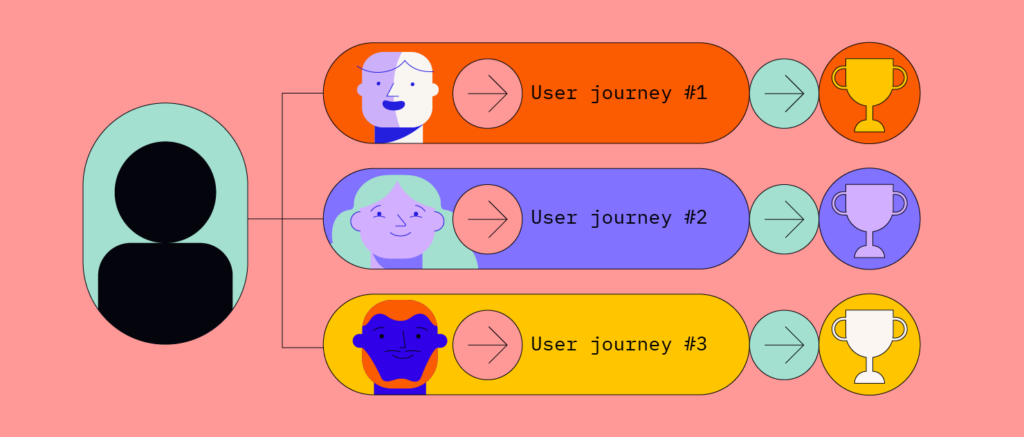User Experience Research (UXR) is too often lumped together with related disciplines like UX and UX Design—but it’s an emerging field that warrants its own spotlight as its role in product development is moving swiftly from "nice to have" to "crucial." In short, UX research is the use of agile qualitative and quantitative research methodology to generate actionable insights about a product’s user base, their behaviors and mental models, and the ways in which they interact with a product.
Arguably, user experience research is what fuels good design processes. At its best, it ensures that product and design teams rely less on assumptions and more on reality. Integrating UX research almost always affects bottom line metrics, whether they be engagement-oriented or revenue-oriented, because a keen sense of who your users are and what they need is the true starting point for creating a great experience.
I lead a small user experience research team at Lightricks where I grew the UXR practice from the ground up and developed a passion (obsession?) with the notion of understanding people as a good business practice. In this article, we’re going to explore everything from the ins and outs of UX research, what a user experience researcher does all day, and how to know when to UXR can be helpful. Let’s dive in.
When and why is UX research helpful?
Here’s the thing: I don’t know what your product is, and I don’t know the target audience you’re building it for—but I do know that your users and potential users have challenges. They live in the context of busy lives, complex emotions, and varying levels of competency and commitment to solving the problems that your product wants to solve.
The alternative to understanding the context in which your users live, and the mental models they have around the things that your organization cares about, is to assume that they think just like you, your product team, or the senior managers driving your organization’s strategy. While there can be overlap, it’s almost never true that the people whose day job it is to build your product and meet your company’s revenue goals think and behave precisely like your users. Enter: UX research. Here’s how and when it helps.
Use UX research to ensure that your product roadmap is solving real-world problems for your end users.
A product roadmap is a plan that communicates what’s going to happen in the product development process for the next few months, year, and so on. It’s when management, product managers, and designers put on paper what they’re going to build and when. When product and design teams are planning their roadmap, features and initiatives make it onto the list for a variety of different reasons, including passion and politics. In reality, though, there is only really one good reason for something to make it onto the product roadmap: it answers end users’ needs and solves real-life problems for target users.
This is exactly where UX research comes in handy. User experience researchers use both quantitative and qualitative methodology, both quickly and reliably, to understand what your users’ needs and remaining challenges are. Before you launch into your UX software and start prototyping, it's important to really understand the user experience you want to build.
For example, let’s say that your company has a financial planning platform for small business owners. With a team of passionate professionals, you could probably create a list a mile long with cool and interesting features that would result in endless debates and prioritization difficulties. But if you use UXR methodology, you can start off with a list of key problems to solve. What are the most difficult challenges and pressing issues that small business owners face daily when they’re managing their finances? What unsolved problems do they have when they use your product, or your competitors’ platforms, when trying to address those challenges?
A UX researcher on the team might use a variety of research methods to answer these questions, such as user interviews, synthesizing user feedback from the customer experience team, focus groups, surveys and questionnaires, user testing and usability studies, and so on. After analyzing the data, researchers will be able to deliver a concise list of insights and recommendations that aren’t just the wishlist of creative product professionals, but rather rooted in the reality of the mental models of small business owners trying to manage their finances. This process holds true for any product, with any target audience.
Evaluative user experience research identifies where your users are getting stuck.
In the design process, product managers and designers are always striving to help users do various tasks within their product in the simplest, most intuitive way possible. Whether your users are there for pleasure or out of necessity, the easier it is to do what they came to do, the more likely that the resulting user behavior will align with the metrics that you’re using to measure success. But how do you know if you’ve built a simple, intuitive interface for your users?
Often, UX researchers start with data looking at user behavior. Where do users drop off and give up? For example, if you have an e-commerce site, your main goal is probably making sure that your users make it from search to purchase. You may notice that a large percentage of users are abandoning their carts for reasons that aren't apparent. A UX researcher might discover that your users aren't able to save their purchase information for future transactions, and can't be bothered to re-type all their billing info and get off the couch to retrieve their credit card.
UX research explains the why behind experiment results so that you can iterate and improve them.
Whether or not a UX researcher is involved in the planning or execution of A/B testing features or flows, the research team is often very useful in helping the product team explain the results of an experiment using qualitative research methods and working with data teams to triangulate what they learn with user behavior metrics.
For example, let’s say that your company has an image editing platform for marketing professionals. Recently, your team added some pop-ups with explanatory guidance when users try out some of the more difficult editing features for the first time, hoping that it would result in a higher rate of image exports—one of your main KPIs. The feature was released as an A/B test, where 50% of the users still had no guidance with complex features, and 50% did. The team ended up disappointed with the results: there was no meaningful increase in export rate for users who had the guidance pop-ups.
In our example, what makes it difficult for the product team to move forward is that it’s not easy to tell why the feature failed to influence the desired metric. Did users simply not see the pop-ups? Did they not understand what they read? Was the guidance inadequate? What if there was no need for guidance to begin with?
There are a range of possibilities, and a UX researcher can help answer these questions so that the product team can decide what to do next – abandon the feature, iterate on it further, and so on. For example, a researcher might decide to do some usability testing to understand whether the pop-ups came up at the right time, or whether users saw them at all. They may also use similar methodology to try and understand if those complex features really are hard for users to utilize, or if there is some other explanation for the drop in image exports.
Wherever you find product testing, you’ll find key use cases for user research. No matter how powerful a team’s analysis is when it comes to user behavior data, understanding why users behave the way they do is often difficult without some qualitative research methodology using the right}.
User research can help segment users for a more nuanced understanding of your target audience

In order for product or service development to be centered around a user-centered design process, knowledge about your users and target audience needs to be as nuanced as possible. If you’re working on a team that’s designing a weight loss app, you’ll soon realize that people want to lose weight for different reasons and have different struggles throughout their journey; trying to find a one-size fits all approach is likely a missed opportunity.
UX researchers can use both qualitative and quantitative research methods to segment your audience and create internal knowledge about different types of users, with deliverables such as personas, so that you can create powerful user journeys for anyone trying to lose weight, whether their goals are aesthetic or health-related.
Unless your product has one, very niche target audience, chances are that your design team will make better design decisions if they use research methodology to understand the nuances of your user base.
User research can even give value to your marketing team
Though UX research typically sits in Product, it’s often the case that UX research can be very relevant and useful for organizations that have a Marketing team. One of the main responsibilities of marketing teams is to come up with, and test the effectiveness of, messaging in your company’s marketing materials. Whether marketing at your organization creates ads for user acquisition, does content marketing, or manages social media accounts—messaging is always key. How do they capture the attention of your potential user base?
Since user researchers are always investigating things like target audience pain points and unmet needs, attitudes, and behaviors, it often happens that new ideas for marketing messaging surface in the process. Larger user research teams with more resources may even choose to do specific research projects that aim to answer questions that their marketing team has about their user base.
Related read: Best Customer Messaging Platforms for Teams
UX research and CX can work together to help companies better meet user needs
The wonderful thing about the relationship between user research and customer experience is that it’s mutually beneficial and works both ways.
CX teams get customer feedback and sometimes, that feedback reflects problems or issues that users are having with your product. If users can’t figure out how to do something and there are a significant number of inquiries or complaints, it’s good practice for CX to reach out to user research. User research can then use usability testing or other methodology to check for UX issues or other problems in the user flow so that you can team up and make things more intuitive.
Similarly, user researchers often have product managers prioritize features or other product initiatives. While UX research offers a ton of methodology for figuring out which problems to solve, CX data on which problems or needs are most pervasive can be a crucial element in what they recommend to the product team. UX researchers will often consult with CX and ask questions about the volume of requests or critical issues reported by users to help determine what product iterations they should be recommending to the product team.
UX Research Methods: how researchers find the answers Your team needs
There is a surprising amount of variation in terms of what methodology different UX researchers use and why. That being said, most user researchers use a variety of qualitative and quantitative user research methods. Let’s talk more about what that means.
Quantitative user research involves methodology that relies on numbers and statistics to answer questions about users that are usually very reliable. For example, A/B testing is a common quantitative research method used to find out which user flows or features help product, marketing, or CX teams influence their key KPIs. Another common quantitative method is surveys, which researchers use to learn more about everything from user sentiments to unsolved problems.
Qualitative user research is research methodology that focuses on broader questions, and usually with smaller, but representative, samples of users. Qualitative methods look at user behaviors, sentiments, pain points, perspectives, and more. User researchers often use one-on-one interviews as a go-to qualitative method, and there are a whole slew of other UX research methods, including focus groups, participatory design, diary studies, and contextual inquiry.
If you glance at open roles for UX researchers, you’ll see that some research roles are defined as either qualitative or quantitative, or mixed methods. Mixed methods research roles expressly require researchers to use both quantitative and qualitative methodology. Still, some roles are more ambiguous, like mine for example: User Research Lead. The latter really does reflect the overall ethos of the user research profession, which is that we don’t really determine the methodology until we know the questions that need to be answered.
In my case, I’m approached by product stakeholders all of the time at Lightricks. My team uses both qualitative and quantitative methodology, depending on the research questions that we need to answer. If we need to understand something at scale, we’ll often turn to methods like surveys. If we need deep, person-centered insights to answer a why question, we’ll often use qualitative methods such as user interviewing.
Other aspects of a researcher’s day-to-day activities vary significantly between roles. For example, some UX researchers conduct in-person research, either close to where they live or via business travel, and spend a significant amount of time interfacing with users. However, there are plenty of research roles where research is conducted virtually for the most part.
What are the roles and responsibilities of a user researcher?

When I first started my journey as a user researcher, I assumed that I’d spend all day, well, conducting research. While that seems like a reasonable assumption, the truth is that employing real research techniques and working with real users is only one part of what a UX researcher does.
One of the most critical elements of being a successful UX researcher is the ability to work effectively with stakeholders. From the perspective of a researcher, stakeholders can include management, designers, product managers, and more.
User researchers spend a significant amount of time meeting and brainstorming with stakeholders in order to define good research questions, clarify the goals of research projects, understand the product team’s most pressing research needs, present research results, and help with the planning and implementation of user research insights and recommendations.
In addition to working with stakeholders and conducting actual research, quantitative and/or qualitative data analysis is a significant time investment for user researchers. For example, if you’re working on a project that involves conducting a set of 15 interviews, you’ll need to code and analyze that data with a specific method, such as affinity mapping, in order to generate actionable insights.
Another prominent part of what a UX researcher is responsible for is reporting. Reporting means taking the insights and recommendations that you’ve generated from your research and creating various deliverables for the rest of your company or organization to consume. Reporting deliverables can range from presentations and written reports, to more creative deliverables like Slack updates, videos, and workshops with stakeholders.
When I think about how I spend my day as a user researcher, what I call impact work is very prominent. Impact work is what happens after you conduct research and report the results to the relevant stakeholders. UX research is action-oriented, meaning that whatever results you deliver will almost certainly have recommendations for product iterations or other suggestions that teams at your company can start working on or looking into. Impact work involves following up with colleagues to make sure that your recommendations are put into motion, or understanding why they aren’t. It may also include attending product or feature planning meetings where you have a relevant perspective.
The main takeaway here is that it is most definitely within the realm of a researcher’s responsibilities to keep track of what happens post-research, and to help bring recommendations from ideas to action.
How can I incorporate more user research in my role?
If you’re a CX professional, designer, marketer, or a product manager at a company without a dedicated UX research team, you can intentionally beef up your research skills to help you do better work. Product professionals tend to have a relevant skill set and a mindset that is reflective of design thinking, which is a great starting point.
To hone your skills in terms of research methods specifically, there are a ton of online courses such as those offered by the Neilsen Norman Group or the Interaction Design Foundation. Ask your manager about whether or not your team has a budget for professional development and expand your skill set!
How can I become a UX researcher?

If you’re interested in becoming a UX researcher, whether you have a product or design background or are pivoting from another field entirely—rest assured that it can be done!
As a starting point, I’d recommend checking your professional network to see if you can find any local researchers and treat them to coffee in exchange for hearing more about the field. Taking the aforementioned courses is also a great way to both start honing your research skills and understanding whether or not you’re really interested in pivoting to UX research. Also, invest time in learning how the best UX testing tools work.
Keep in mind that both paid and unpaid internships are often available for less experienced researchers and, as a bonus, doing an internship counts as experience when you start applying for roles. Some people who are pivoting to user research prefer to go the educational route and pursue a Master’s degree in Human-Computer Interaction (HCI). A degree in HCI definitely gives a leg up in an application process, but for those without the desire to resources to pursue a degree, it’s certainly not a must-have.
For more career advice, I can highly recommend signing up to speak with a UX Researcher on UX Coffee Hours where a ton of user researchers give their time and hard-earned advice to newbies and those toying with entering the field.
UX Research is rapidly developing, and increasingly relevant.
No matter what industry you're in, there's bound to be a lot of fierce competition. Only the companies that truly understand their users succeed, and only those who continuously invest in that understanding have any hope of survival. Whether you personally seek to become a user experience Swiss Army Knife or you're mulling over adding a UX researcher to your team, the question should not be "if", but "when!"
If you’re interested in reading more about UX research, don’t forget to subscribe to the CX Lead newsletter, which contains insights from experts in the field.
Happy researching!
Related read: Best Qualitative Data Analysis Software
Need expert help selecting the right Customer Experience Software?
If you’re struggling to choose the right software, let us help you. Just share your needs in the form below and you’ll get free access to our dedicated software advisors who match and connect you with the best vendors for your needs.



